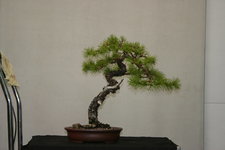you wouldn’t believe how many decay factors there are for our BC conifers and different species have different factors and ranges of decay.
Agreed, I also have spent decades in the woods and was born in BC traipsing the forest and streams for fishing and collecting.
The concept of variation in decay is important to bonsai design and understanding the proper use of deadwood with bonsai.
But I am also of the firm belief that just because it occurs in nature, that does not necessarily equate to aesthetically pleasing for bonsai design. The concept of small jin's not remaining for longer on older pine trees is not just my idea, rather a common principle of design and science of wood type mentioned in many texts and taught by professionals with respect to conifer design. One of my favourite reference texts is Bonsai Aesthetics, by Francois Jeker, published in 2006.
He discusses at length the use of deadwood in design.
One of the
main principles determining the type of deadwood suitable to use on a species is the
hardness of the wood. With only the very hardwood being left with slender jinned branches. I have never considered Pine to be a hardwood let alone a very hardwood.
Jeker also prefaces his discussion with the following comment. " Among Bonsai amateurs, there are two groups who have very divided opinions, the first group violently abhors the presence of deadwood on a bonsai, the second make a systematic and excessive use of it. Nevertheless it is a natural phenomenon on conifers or deciduous trees having hardwood. All one has to do is take a short walk in the mountains to be convinced of this. According to the hardness of the wood, each species of tree will have a different deadwood. Wood of average hardness will result in a hollow trunk. Hardwood will result in a hollow trunk and large jinned branches. Very hardwood will result in a hollow or deadwood trunk and jinned branches even the most slender ones."
His discussion on determining the type of deadwood to use in design based on species and age is very interesting.
Just some additional information for those monitoring the discussion to consider.


 www.janculekbonsai.com
www.janculekbonsai.com






